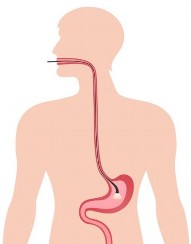What is a hiatus hernia?
In a hiatus hernia, a part of the stomach pushes up through a hole in the diaphragm, the muscle that separates the chest from the abdomen. As a result, part of the stomach moves into the lower part of the chest.
Are there different types of hiatus hernias?
Hiatus hernias are classified into types, depending on which part of the stomach protrudes into the chest cavity:
- In sliding hiatus hernias, the upper part of the stomach (connected to the oesophagus, or ‘food pipe’) slides up into the chest through the diaphragm.
- In paraesophageal hernias, a lower part of the stomach (not connected to the oesophagus) moves into the chest.
More than 9 in every 10 people with hiatus hernias have the sliding type. Rarely, people can have both types of hiatus hernia at the same time. It’s also possible for part of another abdominal organ, such as the small bowel, to protrude through the weakness in the diaphragm.
What are the symptoms of a hiatus hernia?
Many people with a hiatus hernia have no symptoms.
In other people, especially those with large hernias, a hiatus hernia can cause food and acid to move in the wrong direction from the stomach into the oesophagus.
This may cause symptoms of gastroesophageal reflux disease (also known as GORD or ‘reflux’) including:
- chest or abdominal pain
- shortness of breath
- heartburn
- an acidic taste in the back of the mouth
- bringing food or liquids back up into your mouth (regurgitation)
- difficulty swallowing
- vomiting
Some people with a hiatus hernia burp or feel bloated often.
What causes a hiatus hernia?
A hiatus hernia is caused by a weakness in the opening in the diaphragm, allowing part of the stomach to slide through the diaphragm.
It’s not always clear what causes this, but factors that increase your risk of developing a hiatus hernia include:
-
- being over 50 years of age
- being overweight
- excessive straining — for example with frequent coughing, vomiting, lifting or straining when passing a bowel movement
-
being born with a large gap in your diaphragm
When should I see my doctor?
You should see your doctor if:
- your symptoms continue for at least 3 weeks; or
- your symptoms are getting worse; and/or
- over-the-counter medicines aren’t controlling your symptoms
See a doctor right away if you have a hiatus hernia and you experience problems with swallowing, breathing or if:
- you have pain that is getting worse
- you are vomiting frequently
- there is blood in your vomit
How will I be diagnosed with hiatus hernia?
You may be diagnosed with a hiatus hernia if you have tests to find the cause of symptoms such as reflux, chest pain or upper abdominal pain.
These tests may include:
- Barium swallow studies- special x-ray of chest and abdomen with oral contrast
- Endoscopy— where a camera is used to look at the inside of your oesophagus and stomach
- esophageal manometry — a test used to look at the muscles of your oesophagus
What treatment will I need for a hiatus hernia?
If you have symptoms of GORD caused by a hiatus hernia, you can reduce or relieve your symptoms by:
- avoiding foods that worsen your symptoms of reflux – these may include fatty foods, chocolate, mint, alcohol and caffeine
- eating smaller meals
- not lying down straight after eating
- losing any excess weight
- quitting smoking
You can buy antacids over the counter to neutralise stomach acid and relieve your symptoms. There are also other medicines available, and you can talk to your pharmacist or doctor to find out more. A small number of people need surgery.
What are the complications of a hiatus hernia?
A hiatus hernia can cause GORD (reflux), which is when stomach acid flows back into your oesophagus and mouth. Long-term, this can damage your oesophagus.
What does the operation involve?
The operation is performed under a general anaesthetic and usually takes 2 to 3 hours.
During surgery your liver will be held out of the way to give your surgeon a clear view of the hiatus hernia and hole in your diaphragm. Tissues around the hernia will be freed up and the lining of the hernia will be removed from the inside of your chest. Your surgeon will return your oesophagus, stomach and other affected organs to their normal place. They will stitch your diaphragm to reduce the size of the hiatus so it is big enough to only allow your oesophagus to pass through.
Your surgeon will usually wrap and stitch the top part of your stomach around your lower oesophagus. This strengthens the repair and, if acid reflux is a problem, it may reduce the symptoms.
How can I prepare myself for the operation?
If you smoke, stopping smoking now may reduce your risk of developing complications and will improve your long-term health.
Try to maintain a healthy weight. You have a higher risk of developing complications if you are overweight.
Regular exercise should help to prepare you for the operation, help you to recover and improve your long-term health. Before you start exercising, ask the healthcare team or your GP for advice.
What complications can happen? General complications of any operation
- bleeding
- infection of the surgical site
- developing a hernia in the scar
- allergic reaction to the equipment, materials or medication
- blood clot in your leg
- blood clot in your lung
- chest infection
- irregular heartbeat
- heart attack
- death
Specific complications of this operation Keyhole surgery complications
- surgical emphysema (crackling sensation in your skin caused by trapped carbon dioxide gas)
- damage to structures such as your bowel, liver or blood vessels
- developing a hernia near one of the cuts used to insert the ports
- gas embolism
Hiatus hernia surgery complications
- difficulty swallowing for a few months
- pneumothorax, where air escapes into the space around your lung
- the stitches used for the wrap may tear if you retch or vomit in the first few weeks
- making a hole in your oesophagus or stomach
- damage to your liver when holding it out of the way
- wrap migration, where the wrap pushes up through the gap into your chest
- mesh erosion, where the mesh erodes through the oesophagus or stomach
Long-term problems
- continued difficulty swallowing
- inability to burp/ belch.
- tissues can join together in an abnormal way
- weight loss during the first 2 months
- abdominal discomfort
- diarrhoea and excessive flatulence
- recurrence of a hiatus hernia
How soon will I recover?
You will stay in hospital for 24-48hrs.
You will need to eat slowly and chew your food thoroughly. You will be started on clear fluids and slowly upgraded to puree diet for 3-4wks. Dietician will inform you about the gradual upgradation of your diet.
Your doctor will give you antiemetic medications to prevent nausea and vomiting and undue tension on to your repair.
You should be able to return to work after 3 to 4 weeks, depending on your surgery and your type of work.
Your doctor may tell you not to do any manual work for a while. Do not lift anything heavy for a few weeks.
You should make a full recovery, with the symptoms of acid reflux gone or much improved. You should be able to eat and drink normally without feeling sick.



